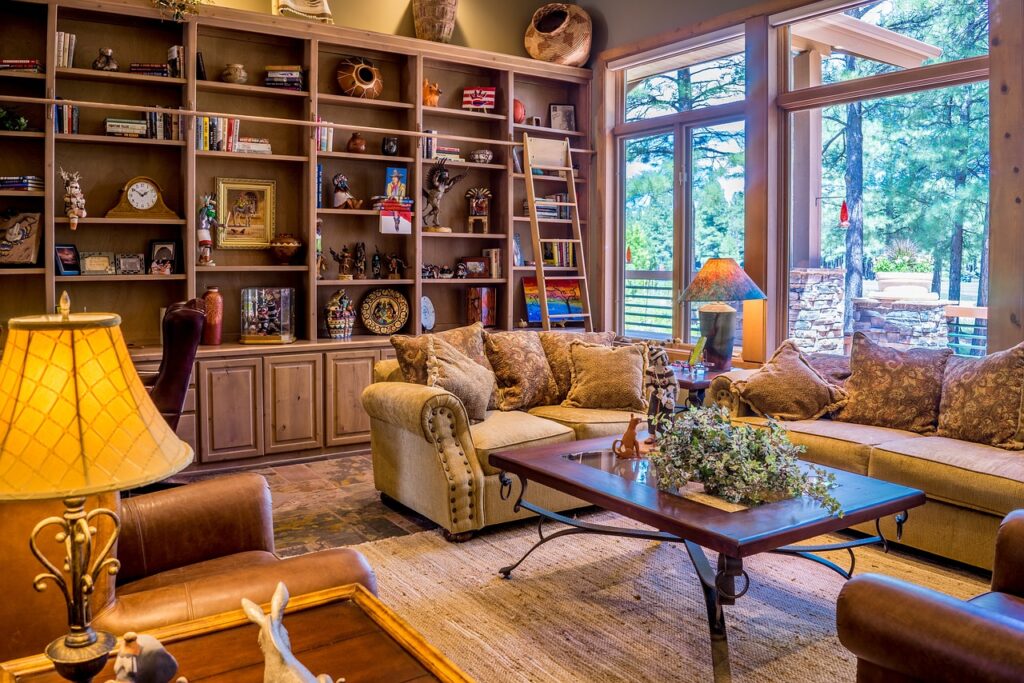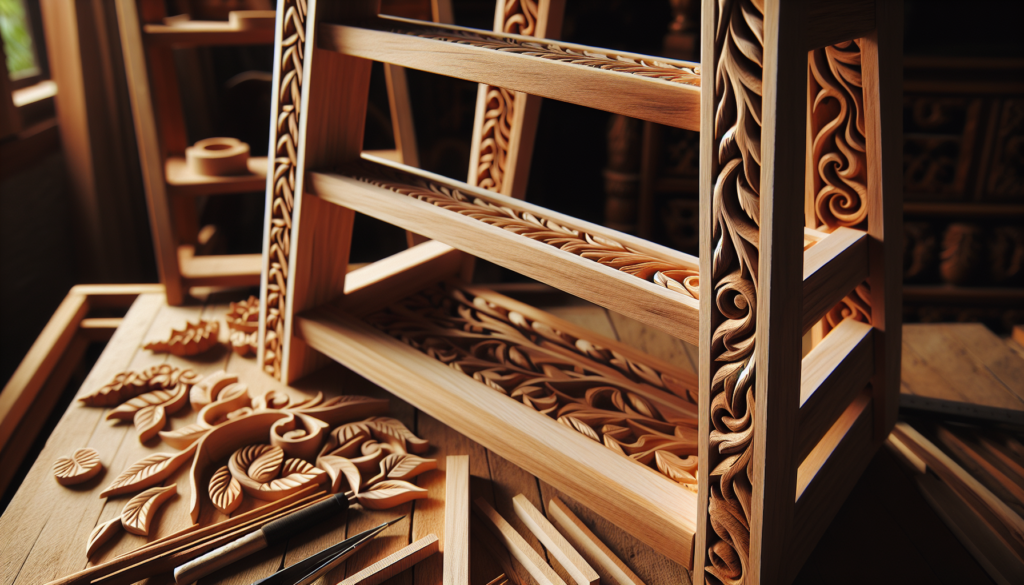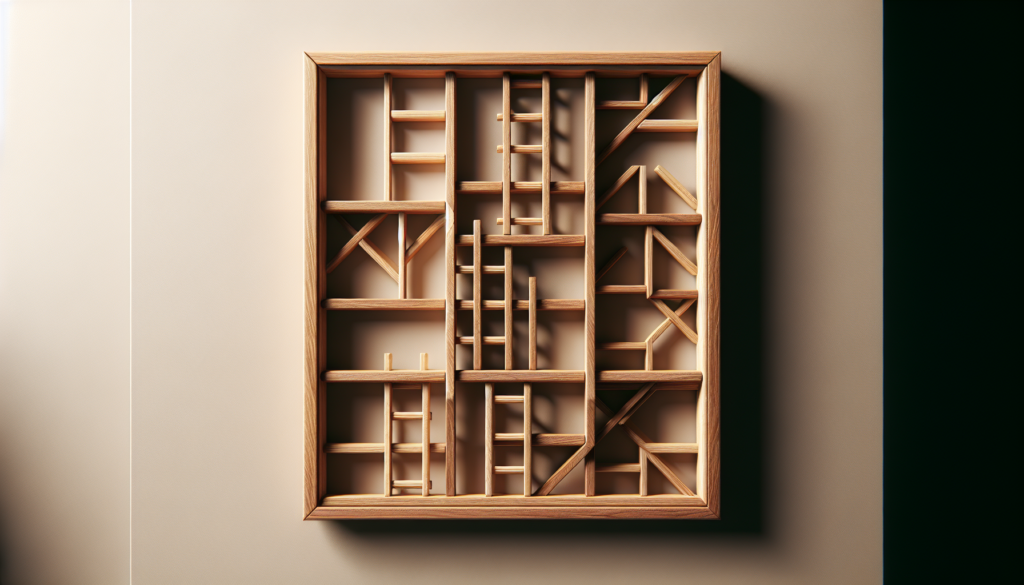How Do I Make A Wooden Ladder Shelf?
Are you looking to add a touch of rustic charm to your home? Look no further! This article will guide you through the step-by-step process of creating your very own wooden ladder shelf. Whether you’re a seasoned DIY enthusiast or just starting out, you’ll find all the information you need to bring this stylish and functional piece to life. Get ready to roll up your sleeves and embark on a fun and rewarding project that will leave you with a beautiful addition to your home decor. Let’s get started!
How Do I Make A Wooden Ladder Shelf?
Gathering Materials and Tools
Before you begin constructing your wooden ladder shelf, you will need to gather all the necessary materials and tools.
Choosing the Right Type of Wood
The first step in making a wooden ladder shelf is to choose the right type of wood for your project. Consider the overall look you want to achieve and factors such as durability and cost. Hardwoods, such as oak or maple, are popular choices for their strength and beauty. Softwoods, like pine or cedar, are more affordable options. Whichever type of wood you choose, make sure it is suitable for indoor use and has been properly dried to prevent warping.
Measuring and Cutting the Wood
Once you have selected the wood, you will need to measure and cut it to the desired dimensions. Start by determining the overall height, width, and depth of your ladder shelf. Measure and mark the wood accordingly, and then use a saw to make the cuts. It is important to ensure that your cuts are accurate and straight for a professional-looking result.
Sanding and Smoothing the Wood
After cutting the wood, it is crucial to sand and smooth the surfaces for a polished finish. Start with a coarse-grit sandpaper to remove any rough edges or imperfections. Gradually move to finer grits to achieve a smooth and even surface. Sand in the direction of the wood grain to avoid creating scratches. Take extra care to sand all visible areas, including the edges and corners.
Selecting and Preparing Hardware
To assemble your ladder shelf, you will need to gather the necessary hardware. This may include screws, nails, brackets, or other fasteners, depending on your design. Consider the weight-bearing capacity of your shelving unit and choose hardware that is strong and durable. Before you begin assembly, it is a good idea to pre-drill any necessary holes for the hardware to ensure a secure fit.
Gathering Necessary Tools
Lastly, gather all the tools you will need to complete the project. Some common tools include a saw, sandpaper, a drill, a tape measure, a level, clamps, and a paintbrush or roller for finishing touches. Having all the necessary tools readily available will help make the construction process smoother and more efficient.
Preparing the Ladder Rungs
Now that you have gathered your materials and tools, it’s time to focus on preparing the ladder rungs.
Determining the Size and Number of Rungs
The size and number of rungs you will need for your ladder shelf will depend on your desired shelf spacing and overall design. Measure the width between the ladder sides to determine the length of your rungs. Additionally, decide on the number of rungs you want based on the height of your ladder shelf and the desired spacing between each shelf.
Cutting and Shaping the Rungs
Using your chosen wood, cut the rungs to the determined length. Ensure that each cut is clean and precise. To add a decorative touch, you can also shape the ends of the rungs by rounding them or creating a unique design. Use a router or sandpaper to achieve the desired shape.
Drilling Holes for the Rungs
To attach the ladder rungs to the ladder sides, you will need to drill corresponding holes. Mark the locations of the holes on both the rungs and the ladder sides, ensuring that they align. Use a drill bit that matches the diameter of your chosen hardware to create the holes. Take care to drill straight and at the correct depth to avoid compromising the stability of the ladder.
Sanding and Finishing the Rungs
After drilling the holes, it is essential to sand and finish the ladder rungs. Sand all the surfaces to remove any roughness left by the cutting and drilling processes. Pay attention to the edges and corners to ensure a smooth finish. If desired, apply wood stain or paint to enhance the appearance of the rungs. Finish with a protective sealant to prolong the life of the wood.

Constructing the Ladder Sides
With the rungs prepared, it’s time to move on to constructing the ladder sides of your shelf.
Measuring and Cutting Side Rails
Start by measuring and cutting the side rails according to the desired height of your ladder shelf. Take into account the thickness of the rungs when determining the length of the side rails. If you prefer tapered sides, mark the tapering angle on each side rail before cutting. Remember to double-check your measurements to ensure accuracy.
Attaching Rungs to the Side Rails
To assemble the ladder sides, align the pre-drilled holes on the rungs with the corresponding positions on the side rails. Insert your chosen hardware, such as screws or dowels, into the holes and tighten them securely. Ensure that the rungs are evenly spaced and perpendicular to the side rails. Use a level to check for straightness and make any necessary adjustments.
Reinforcing the Ladder Sides
To add extra stability and strength to your ladder shelf, consider reinforcing the ladder sides. This can be done by attaching additional support pieces, such as diagonal braces or reinforcing brackets, to the ladder sides. Ensure that the reinforcing elements are securely fastened and will not interfere with the placement of the shelves.
Sanding and Finishing the Ladder Sides
After constructing the ladder sides, it is important to sand and finish them for a smooth and appealing look. Sand all the surfaces, paying attention to any rough edges or imperfections. Take extra care when sanding around the areas where the rungs attach to the side rails to ensure a seamless transition. Finally, apply a wood stain or paint of your choice and protect the wood with a sealant.
Building the Shelves
With the ladder sides completed, it’s time to move on to building the shelves for your ladder shelf.
Determining Shelf Dimensions
Decide on the dimensions and spacing of your shelves based on your intended purpose and the items you plan to display. Measure and mark the desired lengths and widths on the chosen shelf boards. Ensure that these dimensions are appropriate for the ladder sides and will fit securely in place.
Cutting and Sanding Shelf Boards
Using the measurements from the previous step, cut the shelf boards to the desired lengths. Make clean and precise cuts to avoid any gaps or unevenness. Sand all the surfaces of the shelf boards to achieve a smooth and splinter-free finish. Pay attention to the edges and corners, as well as the top and bottom surfaces, to ensure a polished look.
Attaching Shelf Boards to the Ladder
To attach the shelf boards to the ladder sides, first, determine the desired placement of each shelf. Mark the positions on the ladder sides and use clamps or temporary support blocks to hold the boards in place. Pre-drill holes through the ladder sides into the shelf boards, and then secure them with screws or other appropriate fasteners. Double-check that each shelf is level and evenly spaced before fully tightening the fasteners.

Stabilizing the Ladder Shelf
To ensure the stability and safety of your ladder shelf, it is important to implement additional measures.
Installing Back Braces
Back braces can provide extra stability and prevent the ladder shelf from wobbling or tipping backward. Measure the distance between the ladder sides near the top and bottom, then cut pieces of wood or metal to fit. Attach these braces to the ladder sides using screws or other appropriate hardware. Make sure the braces are securely fastened to prevent any movement or instability.
Securing the Shelf to the Wall
To prevent the ladder shelf from tipping forward, it is essential to secure it to the wall. Locate the wall studs and mark their positions on the ladder sides. Use appropriate screws and anchors to attach the ladder sides securely to the wall studs. Ensure that the ladder shelf is level and the connection to the wall is sturdy before fully tightening the screws.
Adding Anti-Tip Measures
For additional safety, consider adding anti-tip measures to your ladder shelf. This can include attaching brackets or straps from the top of the ladder sides to the wall or floor. These measures will further reduce the risk of the ladder shelf tipping over, especially when children or pets are around. Ensure that the anti-tip measures are tight and firmly anchored for optimal effectiveness.
Applying Finishing Touches
With the construction of your ladder shelf complete, it’s time to add the finishing touches that will enhance its appearance and longevity.
Filling Gaps and Imperfections
Inspect your ladder shelf for any gaps or imperfections that may be visible. Use wood filler or putty to fill in these areas, following the manufacturer’s instructions. Allow the filler to dry completely before sanding it to a smooth and flush finish. Once the surface is even, you can proceed to the next step of finishing.
Applying Wood Stain or Paint
Apply wood stain or paint to your ladder shelf based on your desired aesthetic. Before proceeding, ensure that the surface is clean and free of dust. Apply the stain or paint evenly, following the manufacturer’s instructions for drying times between coats. Take care to cover all visible areas, including the ladder sides, rungs, and shelves. Allow the stain or paint to dry completely before moving on to the next step.
Sealing and Protecting the Wood
To protect the wood and enhance its longevity, apply a sealant or protective finish. Choose a product specifically designed for interior wood surfaces and follow the application instructions. Apply the sealant evenly, using a brush or roller, and allow it to dry completely. Multiple coats may be necessary for optimal protection. Once the sealant has cured, your ladder shelf will be better equipped to withstand daily use and potential damage.
Adding Decorative Elements
To personalize your ladder shelf, consider adding decorative elements that reflect your style and taste. This could include attaching decorative trim, applying decals or stencils, or even adding small shelves or hooks for additional storage. Let your creativity guide you in making these final touches that will make your ladder shelf truly unique.

Tips and Safety Precautions
When constructing a wooden ladder shelf, it is important to keep a few tips and safety precautions in mind.
Double-Check Measurements and Cuts
Before making any cuts or attaching components, double-check all measurements and cuts to ensure accuracy. This will help you avoid costly mistakes and ensure a more professional-looking result.
Wear Appropriate Safety Gear
When working with tools or handling wood, always prioritize safety. Wear protective gear such as safety glasses, gloves, and a dust mask to protect yourself from potential hazards and dust particles.
Use Clamps or Jigs for Stability
To ensure precise and stable construction, use clamps or jigs to hold components in place while drilling or attaching. This will help avoid mistakes and improve the overall quality of your ladder shelf.
Start with Lighter Stains or Paints
If you are new to woodworking or finishing, it is advisable to start with lighter stains or paints. This will allow you to achieve a more forgiving finish and learn from any mistakes along the way.
Consider Weight Distribution on Shelves
Remember to distribute the weight of items on your ladder shelf evenly across the shelves. This will prevent undue stress on any particular shelf and help maintain the stability of the entire structure.
Troubleshooting and Common Issues
While building a wooden ladder shelf, you may encounter a few common issues. Here are some troubleshooting tips to help you overcome them.
Uneven or Wobbly Ladder
If your ladder shelf is uneven or wobbly, check that all the components are securely attached and leveled. Re-tighten any loose fasteners and ensure that the ladder sides are perpendicular and the shelves are level. Consider adding additional support or reinforcement if necessary.
Difficulty with Joinery or Hardware
If you are having difficulty with joinery or hardware, take a step back and assess the situation. Double-check that the measurements and cuts are accurate, and ensure that you are using appropriate hardware for the intended purpose. Consider seeking advice or assistance from experienced woodworkers if needed.
Gaps between Boards
If you notice gaps between the shelf boards or rungs, consider using wood filler or putty to fill in these areas. Apply the filler, allow it to dry, and sand it until the surface is smooth and flush.
Excessive Splintering
If you experience excessive splintering during the cutting or drilling process, make sure to use sharp tools and go slowly. Consider using a scoring method or masking tape on the surface to reduce splintering. Sand any rough edges to achieve a smooth finish.

Alternative Design Ideas
If you want to explore different design options for your wooden ladder shelf, here are a few alternative ideas to consider.
A-Frame Ladder Shelf
An A-frame ladder shelf features a triangular shape, with the ladder sides forming an “A” shape. This design offers a more open and airy look, making it perfect for minimalist or modern interiors.
Floating Ladder Shelf
A floating ladder shelf is designed to appear as though it is floating on the wall, with hidden wall mounts or brackets supporting it. This style creates a sleek and contemporary look, while also maximizing floor space.
Leaning Ladder Shelf
For those who prefer a more relaxed and casual vibe, a leaning ladder shelf is a great option. It leans against the wall without attaching to it, offering flexibility and easy movability.
Multi-Tier Ladder Shelf
If you need additional storage space, consider a multi-tier ladder shelf. This design features multiple shelves at different heights, providing ample space for displaying a variety of items.
Conclusion
Congratulations! You have successfully learned how to make a wooden ladder shelf. By following the steps outlined in this article and considering the alternative design ideas, you can create a beautiful and functional piece of furniture that adds character and style to any room. Remember to gather all the necessary materials and tools, measure and cut the wood accurately, and take care to sand, finish, and protect your ladder shelf. With proper construction and maintenance, your ladder shelf will serve you for years to come. Enjoy the process and have fun showcasing your creativity with this DIY project!


